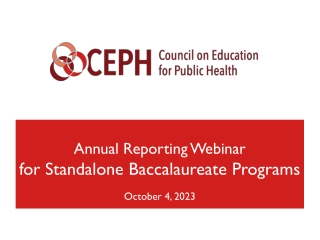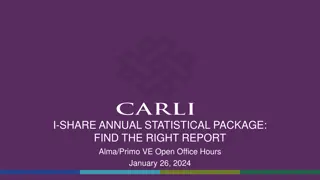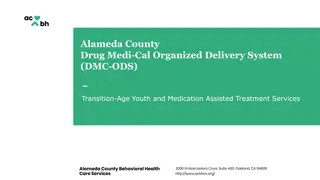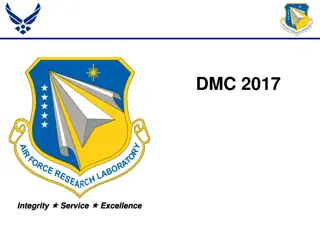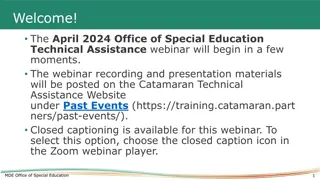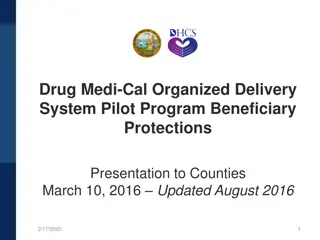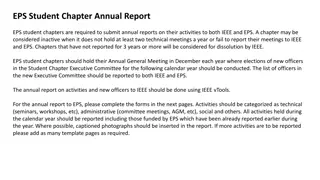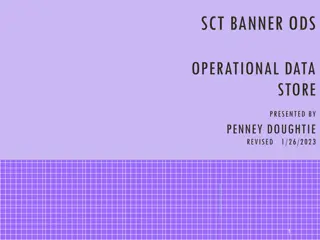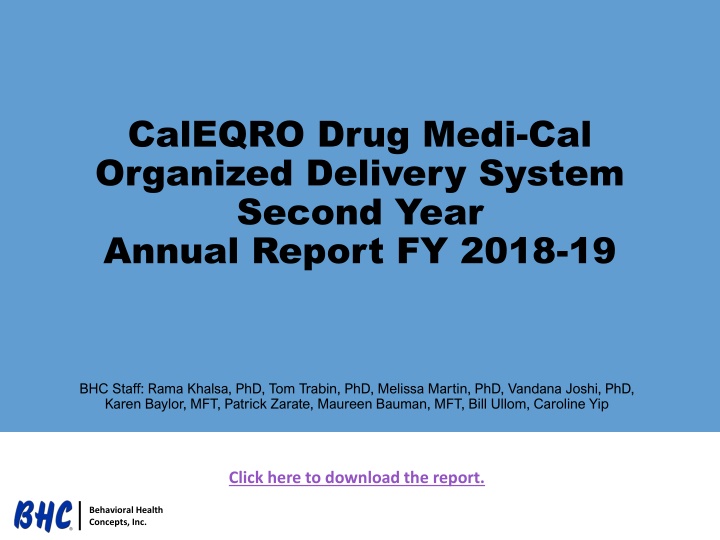
Annual Report on CalEQRO Drug Medi-Cal Organized Delivery System FY 2018-19
This report covers the second-year findings of the CalEQRO Drug Medi-Cal Organized Delivery System (DMC-ODS) focusing on meeting CMS requirements, documenting lessons learned, analyzing strengths and challenges, and recommending improvements to enhance quality based on data and qualitative sources.
Download Presentation

Please find below an Image/Link to download the presentation.
The content on the website is provided AS IS for your information and personal use only. It may not be sold, licensed, or shared on other websites without obtaining consent from the author. If you encounter any issues during the download, it is possible that the publisher has removed the file from their server.
You are allowed to download the files provided on this website for personal or commercial use, subject to the condition that they are used lawfully. All files are the property of their respective owners.
The content on the website is provided AS IS for your information and personal use only. It may not be sold, licensed, or shared on other websites without obtaining consent from the author.
E N D
Presentation Transcript
CalEQRO Drug Medi-Cal Organized Delivery System Second Year Annual Report FY 2018-19 BHC Staff: Rama Khalsa, PhD, Tom Trabin, PhD, Melissa Martin, PhD, Vandana Joshi, PhD, Karen Baylor, MFT, Patrick Zarate, Maureen Bauman, MFT, Bill Ullom, Caroline Yip Click here to download the report. Behavioral Health Concepts, Inc.
Goals of the DMC-ODS EQRO Report Meet all requirements of CMS 438 related to External Quality Review (EQR) protocols and requirements. Document Key Lessons learned on quality issues related to first two years of DMC-ODS services as defined in the 1115 Demonstration Waiver Access, Timeliness, Quality & Outcomes. Document strengths of the DMC-ODS design that enhanced quality related to client care, efficiency, and accountability and County/DMC-ODS Plan challenges and processes for successful Waiver implementation. Analyze and recommend improvements in the DMC-ODS activities to enhance quality based on data from Performance Measures and qualitative sources such as client focus groups, site visits, staff and stakeholder experiences. Behavioral Health Concepts, Inc. 2
Methods Methods Fourteen Counties Reviewed: Fourteen Counties Reviewed: Eleven in Year One & Three in Year Two of Eleven in Year One & Three in Year Two of Services Services Year One of DMC-ODS Services: San Francisco, Napa, Orange, San Diego, Imperial, San Luis Obispo, Santa Cruz, Santa Clara, Contra Costa, Nevada, Monterey Year Two of DMC-ODS Services: Riverside, Marin, and San Mateo Data Sources: Paid/Pending DMC-ODS Medi-Cal Claims, Client Medi-Cal Eligibility File (MMEF), CalOMS, ASAM Level of Care (LOC) Referral Data, Treatment Perception Survey (TPS) Results Groups: Stakeholder & Client Focus Groups, Meetings with Health Plans, Criminal Justice, Youth Partners, SUD Network Providers, SUD staff groups, and community/board members Data from Documents: Access Call Center Key Indicators, Behavioral Health Concepts, Inc. Continuum of Care Form, Timeliness Assessment Form, Information System Capability Assessment, Quality Improvement and Cultural 3
DMC DMC- -ODS County Services Launch Dates ODS County Services Launch Dates Oct-18 Jul-18 Jul-18 Jul-18 Jul-18 Jul-18 Apr-18 Dec-17Jan-18 Jan-18 Dec-17 Sep-17 Jun-17 Jun-17Jul-17 Jul-17 Jun-17 Apr-17 Feb-17Feb-17 Mar-17 Nov-16 Aug-16 May-16 Riverside Santa Clara San Luis Obispo Nevada San Mateo Los Angeles Santa Cruz San Diego Marin San Francisco Imperial Contra Costa Napa Monterey Behavioral Health Concepts, Inc. 4
Percent of DMC Percent of DMC- -ODS Services Contracted Versus County Operated Contracted Versus County Operated ODS Services County Operated Contractor Operated 100 100 100 99.63 99 95 94 99 87 82 75 71 65 62 38 35 29 25 0 0 18 0 13 0.37 5 1 6 1 San Mateo 0 100 San Los Contra Costa 13 87 Santa Cruz 18 82 Santa Clara 25 75 San Luis Obispo 99 1 Monterey San Diego Nevada Marin Riverside Imperial Napa Francisco 0.37 99.63 Angeles 1 99 County Operated Contractor Operated 0 0 5 95 6 94 29 71 38 62 65 35 100 100 Behavioral Health Concepts, Inc. 5
Strengths of DMC-ODS Waiver Design Continues Positive Impacts CalEQRO continued to see positive impacts and outcomes linked to the design of the 1115 Waiver Design for clients and systems: Structured, science-based System of Care/Levels of Care based on American Society of Addiction Medicine (ASAM) research and methods. Individualized treatment and client-centered approach as recommended by Institute of Medicine (IOM) and the Surgeon General s Addiction in America recommendations. Evidence-based practices including Medication Assisted Treatment (MAT), Cognitive Behavioral Therapy, Motivational Interviewing, Seeking Safety and others and up-to-date treatment modalities within a more extensive continuum of care. Field and community-based treatment access to reach vulnerable and high-risk populations which particularly helped youth and homeless. Access to MAT pharmaceutical treatments for low-income individuals as part of benefit design. Behavioral Health Concepts, Inc. 6
Strengths of Waiver Design (contd) Licensed clinicians and medical directors were added to clinical programs to enhance quality of treatment. Measurable standards for accessibility, timeliness, and network adequacy were added to the SUD system. Waiver of IMD exclusion included three levels of residential treatment and withdrawal management which positively impacted access to treatment. Selective contracting made the county fully responsible for network selection based on quality and cost-effectiveness in a managed care framework. Requirements for mental health and physical health coordination of care. Systematic regional implementation plan which enhanced learning capacity and refinements to billing and policies and procedures. Behavioral Health Concepts, Inc. 7
Traditional DMC vs. DMC Traditional DMC vs. DMC- -ODS Benefits ODS Benefits Outpatient Drug-Free Treatment Perinatal Intensive Outpatient Treatment Perinatal Residential Treatment (16 beds only) Inpatient Hospital Detoxification Narcotic Treatment Program Services (Methadone) Outpatient Services Intensive Outpatient Services Residential Treatment Services (no bed limit) 3.1, 3.3, 3.5 Withdrawal Management (residential 3.2) Narcotic Treatment Program Services (Methadone, Buprenorphine, Disulfiram, and Naloxone) Recovery Services Case Management Physician Consultation Additional MAT (optional) 3.7 and 4.0 Withdrawal Management with medical oversight and management DMC-ODS Traditional DMC Behavioral Health Concepts, Inc. 8
Uncertainty about the ACAs Future is Uncertainty about the ACA s Future is Creating Challenges Creating Challenges The ACA expanded access to SUD care even before approval of California s 1115 Waiver Source of Benefits for Patients in DMC-ODS Counties Ongoing legal challenges to the ACA threaten access to SUD treatment for low income single adults 36% 64% Uncertainty about the future of ACA benefits is a barrier to recruitment of new service providers especially for new services requiring capital outlay for start-up ACA Linked Benefits Non-ACA Benefits Behavioral Health Concepts, Inc. 9
County Strengths & Key Roles Leadership and effective communication with stakeholders, elected officials, staff and providers, clients and the general public. There were numerous examples of champion behavior that led to commitment of resources, openness of change, innovation with challenges, inspiration of staff and community members including family and persons suffering from SUD. Expanded clinical and administrative resources with newly certified providers and expanded capacity with existing providers. Adopted new quality improvement (QI) systems, measures, and goals as reflected in excellent quality improvement plans, and promote the value of true QI systems. Partnering with mental health and physical health in expanded and effective ways as a part of the health delivery system with a mission and role to assist and coordinate care, in many counties as part of Whole Person Care. Behavioral Health Concepts, Inc. Demonstrated leadership in finding solutions for 10
County Strengths & Key Roles (contd) New Administrative Managed Care systems for authorizations, billing and cost reporting systems linked to revised rate structure were adopted and improved in active partnership with DHCS administration. Flexibility and Innovation problems arose as initial counties started services and billing and data reporting; it was a fly the plane while building process, and again leadership and can-do attitudes led programs through this challenging change process. New Partnership with Criminal Justice coordinated ASAM evaluations for detainees and those on probation, recommendations with care management, introduction of MAT into detention and transition services back into the community and treatment matching including optimal use of MAT to enhance outcomes. Pushing against Stigma to add new providers into community settings against neighborhood opposition, reducing fears of SUD clients and the biases against MAT. Even county DMC-ODS programs entering their third year of services were still Behavioral Health Concepts, Inc. adding new sites, and more capacity to existing sites, and making 11
Behavioral Health Concepts, Inc. 12
Best Practices in DMC-ODS Programs Extensive Training of Providers and Support staffin new ASAM treatment modalities, new documentation requirements, and new billing/cost report systems (online & in person). Because these are major shifts, repeat trainings and technical assistance are necessary as clinicians learn new techniques and evidence-based practices, and new ways to document them. Adding additional staff in county and contract programs to provide clinical services considering additional new data and documentation requirements, as well as adding case management and recovery support if these are components of the program design and contracts. Behavioral Health Concepts, Inc. 13
Best Practices in DMC-ODS Programs (cont d) 24-Hour Access Call Centers to link communities in need with treatment and ASAM assessments to match clients with optimal levels of care. Best practices include:. Three-way calling capacity to link clients, providers, call center staff and others. Walk-in assessment times at key locations with varied hours for easy appointments. Real time database systems of available beds and outpatient slots critical for appointments and placement access, and client matching to optimal care. Call software to track dropped calls, wait times, volumes, dispositions, referrals, links to EHR for appointments and opening cases to begin treatment. Behavioral Health Concepts, Inc. 14
Three-way calling capacity Perform a brief ASAM-based screening to ensure the client s service needs match referral location Automated central systems for tracking daily provider capacity for new admissions Designated walk-in hours at key program sites for ASAM assessments Implement no- wrong-door systems Best Specialized call center software to track key metrics and link to the history of the caller Special access systems for persons whose situations might be considered urgent Practices for Improving Access Behavioral Health Concepts, Inc. 15
Best Practices in DMC-ODS Programs (cont d) Performance Improvement Projects (PIPs) that contribute to the SUD field and improve care access issues for youth, call centers success, needs of physically disabled, are active; timeliness of services, screening, grievances are active; quality of services and engagement measured by satisfaction and completion rates using CalOMS are active. TA is available on these and other PIP issues. Learning collaboratives to help with challenging areas of system change such as: adding MAT to residential and outpatient programs, working with neighborhoods on introducing new SUD programs into the community, and gaining respect and support for programs and residents. Cultural Competence Plans focused on populations prominent in SUD services, including use of broad community partnerships to leverage resources for aftercare including housing, education, workforce, and vocational entry systems. Behavioral Health Concepts, Inc. 16
DMC-ODS MAT Best Practices In 2018-19 Reviews County DMC-ODS programs showed extensive efforts to expand their MAT programs, including for non- methadone medications, in a variety of ways. Most had multiple strategies to expand access: New and expanded DMC Outpatient MAT programs; Coordinated Clinical FQHC Primary Care access to MAT; Opioid Safety Coalitions; MAT Learning Collaboratives with SUD residential and outpatient providers wanting to add MAT but needing TA and support; Emergency Department Bridge grantees and hospitals; Sheriffs and criminal justice staff introducing MAT services in detention and Probation programs, and NTP encouragement and support to expand to access to all MATs. Behavioral Health Concepts, Inc. 17
Behavioral Health Concepts, Inc. 18
Access to Care Key Component Ratings Access to Care Key Component Ratings Cultural Competence Manage Capacity 7% 7% 7% 14% 79% 86% Met Partially Met Not Met Met Partially Met Not Met Use of Community 7% 93% Met Partially Met Not Met Behavioral Health Concepts, Inc. 19
PERFORMANCE MEASURES Behavioral Health Concepts, Inc. 20
SUD Penetration Rates (NSDUH statewide estimates of SUD need), by County, CY 2018 using UCLA Calculation Method NSDUH Penetration Rates Monterey 3.7% Napa 4.1% Los Angeles 6.3% San Diego 6.7% Santa Clara 6.8% Contra Costa 7.0% San Mateo 7.9% Imperial 8.7% Riverside 8.9% Nevada 13.8% Santa Cruz 15.1% San Francisco 17.8% San Luis Obispo 19.8% Marin 24.3% 0% 5% 10% 15% 20% 25% 30% Behavioral Health Concepts, Inc. 21
Beneficiaries Served and Beneficiaries Served and Medi Rates, by Age Group, 14 Counties as Compared Rates, by Age Group, 14 Counties as Compared with Statewide, CY 2018 with Statewide, CY 2018 Medi- -Cal Penetration Cal Penetration Average Number of Eligibles per Month Number of Beneficiaries Served 14 County Penetration Statewide Penetration Age Groups Rate Rate Age Group 12-17 820,748 2,199 0.27% 0.03% Age Group 18-64 3,988,837 41,990 1.05% 0.46% Age Group 65+ 781,869 4,764 0.61% 0.25% Total 5,591,454 48,953 0.88% 0.31% Behavioral Health Concepts, Inc. 22
Beneficiaries Served and Penetration Rates, by Race/Ethnicity, Beneficiaries Served and Penetration Rates, by Race/Ethnicity, 14 Counties as Compared with Statewide, CY 2018 14 Counties as Compared with Statewide, CY 2018 Number of Beneficiaries Served 14 County Penetration Average Number of Eligibles per Month Statewide Race/Ethnicity Penetration Rate Rate White 947,599 18,482 1.95% 0.60% Latino/Hispanic 2,854,445 17,449 .61% 0.22% African American 464,567 5,359 1.15% 0.44% Asian/Pacific Islander 647,449 837 .12% 0.05% Native American 13,353 342 .56% 0.48% Other 664,060 6,484 .98% 0.32% Total 5,591,473 48,953 .88% 0.31% Behavioral Health Concepts, Inc. 23
Percentage Served by Diagnosis Codes for Percentage Served by Diagnosis Codes for all DMC all DMC- -ODS Counties, CY 2018 ODS Counties, CY 2018 Inhalent Abuse 0.03% Hallucinogen Dependence 0.3% Sedative, Hypnotic Abuse 0.6% Other Psychoactive Substance 0.8% Other 1.4% Cocaine Abuse or Dependence 2.4% Cannabis Use 8.0% Alcohol Use Disorder 16.0% Other Stimulant Abuse 25.1% Opioid 45.4% 0% 5% 10% 15% 20% 25% 30% 35% 40% 45% 50% Behavioral Health Concepts, Inc. 24
Ratings of Client Progress at Discharge, Overall Ratings of Client Progress at Discharge, Overall for All DMC for All DMC- -ODS Counties, CY 2018 ODS Counties, CY 2018 Average Percent Minimum Percent Maximum Percent Discharge Types from CalOMS Completed Treatment - Referred 13% 2% 24% Completed Treatment - Not Referred 27% 2% 48% Left Before Completion with Satisfactory Progress - Standard Questions 15% 5% 55% Left Before Completion with Satisfactory Progress Administrative Questions Subtotal of Positive Outcome Ratings 6% 0% 12% 60% Left Before Completion with Unsatisfactory Progress - Standard Questions 21% 7% 27% Left Before Completion with Unsatisfactory Progress - Administrative 18% 1% 53% Death <1% 0% 1% Incarceration Subtotal of Negative Outcome Ratings Total 1% 0% 5% 40% 100% Behavioral Health Concepts, Inc. 25
Timely Access to Methadone Medication in NTPs after First Client Contact % of Clients Served Age Groups # of Clients Served Average Days Ages 18-64 27,044 81% <1 Ages 65+ 6,250 19% <1 TOTAL 33,294 100% <1 *Less than 10 youth ages 12-17 served, so not included in analysis Behavioral Health Concepts, Inc. 26
Percent of Clients by County Receiving Non Percent of Clients by County Receiving Non- -Methadone MAT from DMC from DMC- -ODS claims from NTP/OTPs ODS claims from NTP/OTPs Methadone MAT 35% 29% 30% 25% 23% 20% 15% 9% 10% 8% 7% 4% 5% 3% 1% 0% 0% 0% 0% 0% 0% 0% 0% Behavioral Health Concepts, Inc. 27
Number of Claims & Clients Served with Non-Methadone MAT in NTP/OTPs- CY 2018 and 2019 (18 months) Number of Claims 2,396 Unique Clients Percent 72 Percent 7.2% BUPRENORPHINE 2 MG TABLET SL 4.5% BUPRENORPHINE 8 MG TABLET SL 7,304 21.9% 173 10.7% BUPRENORPHINE-NALOXONE 2-0.5 MG SL TABLET 2,249 6.8% 84 5.2% SUBOXONE 8 MG-2 MG SL FILM 6,886 20.7% 57 3.5% DISULFIRAM 250 MG TABLET 126 0.4% 4 0.2% DISULFIRAM 500 MG TABLET 104 0.3% 3 0.2% NALOXONE HCL .5 MG TABLET* 479 1.4% 11 0.7% NALOXONE HCL 2MG TABLET* 1,263 3.8% 55 3.4% NARCAN 4 MG NASAL SPRAY* 1,214 3.6% 1,002 62.0% *overdose prevention meds Total Non-Methadone Meds by NTP/OTPs 33,285 100.0% 1,616 100.0% Behavioral Health Concepts, Inc. 28
Number Clients with at Least One and at Least Number Clients with at Least One and at Least Three Non Three Non- -Methadone MAT Billed Visits by County Methadone MAT Billed Visits by County - - CY 2018 CY 2018 from Outpatient & NTP services from Outpatient & NTP services 700 1493 600 500 400 300 704 200 100 0 # of clients with at least 1 MAT service # of clients with at least 3 MAT services Behavioral Health Concepts, Inc. 29
Timely Transitions in Care Post Timely Transitions in Care Post- -Residential Treatment, CY 2017 Treatment, CY 2017 CY 2018, Year 2 Counties CY 2018, Year 2 Counties Residential 20% 18.2% 18% 16.6% 16% 13.2% 14% 11.6% 12% 10.5% 9.5% 10% 7.6% 8% 7.0% 6% 4% 2% 0% Within 7 days Within 14 days Within 30 days Any Days CY 2017 CY 2018 Behavioral Health Concepts, Inc. 30
Percent High Percent High- -Cost Beneficiaries at 90% or Cost Beneficiaries at 90% or above Statewide DMC Costs CY 2018 above Statewide DMC Costs CY 2018 10% 9% 9% 8% 7% 7% 6% 5% 5% 5% 4% 3% 2% 1% 0% 0% Small Medium Large Very Large All DMC-ODS Behavioral Health Concepts, Inc. 31
Number of Withdrawal Management (WM) Clients Number of Withdrawal Management (WM) Clients and Percent with 3 or more WM episodes with no and Percent with 3 or more WM episodes with no other treatment other treatment 14 DMC-ODS Counties Statewide Percent with 3+ Episodes & no other services Percent with 3+ Episodes & no other services Number of WM Clients Number of WM Clients 3,368 1.2% 3,794 1.95% TOTAL Behavioral Health Concepts, Inc. 32
Rates of WM Readmissions by County Size and Rates of WM Readmissions by County Size and Overall for DMC Overall for DMC- -ODS Counties within 30 days, ODS Counties within 30 days, CY 2018 CY 2018 12% 10% 10% 8% 6% 6% 5% 4% 4% 2% 0% 0% Small Medium Large Very Large Overall Behavioral Health Concepts, Inc. 33
Treatment Initiation and Engagement Behavioral Health Concepts, Inc. 34
Clients Initiating and Engaging in DMC Clients Initiating and Engaging in DMC- -ODS Services by for Year Two DMC Services by for Year Two DMC- -ODS Counties, CY 2018 CY 2018 ODS ODS Counties, 100% 92.6% 92.0% 88.8% 88.6% 90% 84.5% 80% 75.3% 72.7% 71.3% 70% 60% 50% 40% 30% 20% 10% 0% Clients Initiating DMC-ODS Services Clients Engaging in DMC-ODS Services Marin Riverside San Mateo Statewide Behavioral Health Concepts, Inc. 35
Initial DMC Initial DMC- -ODS Service Used by Clients for ODS Service Used by Clients for entering treatment, for Year Two entering treatment, for Year Two DMC DMC- -ODS Counties, CY 2018 ODS Counties, CY 2018 45% 41% 40% 40% 35% 31% 30% 29% 30% 27% 27% 26% 24% 25% 20% 18% 18% 17% 15% 14% 13% 11% 11% 10% 6% 6% 5% 5% 5% 1% 0% 0% 0% 0% 0% 0% 0% 0% Outpatient Intensive Outpatient OTP/NTP Non-Methadone MAT Ambulatory Withdrawal Residential Treatment Withdrawal Management Marin Riverside San Mateo Statewide Behavioral Health Concepts, Inc. 36
Cumulative Length of Stay in DMC Cumulative Length of Stay in DMC- -ODS Services, by County and for All Year Two DMC County and for All Year Two DMC- -ODS Counties, CY 2018 CY 2018 ODS Services, by ODS Counties, 60% 56% 50% 46% 46% 41% 40% 37% 30% 27% 24% 23% 19% 20% 16% 13% 11% 10% 0% Clients with at least 90 days Clients with at least 180 days Riverside Clients with at least 270 days Statewide Marin San Mateo Behavioral Health Concepts, Inc. 37
Use of ASAM Criteria Findings to Guide Level of Care (LOC) Use of ASAM Criteria Findings to Guide Level of Care (LOC) Referrals for All DMC Referrals for All DMC- -ODS Counties, CY 2018 CY 2018 ODS Counties, Initial Initial Follow-up Assessment ASAM LOC Referrals Screening Assessment January-December 2018 Not Applicable No Difference Patient Preference LOC Not Available Clinical Judgement Geographic Accessibility Family Responsibility Legal Issues Lack of Insurance/Payment Source Other Actual Referral Missing Total % % % 44.01% 87.58% 88.01% 3.78% 3.02% 2.48% 0.32% 0.00% 0.00% 3.32% 0.66% 0.62% 0.08% 0.08% 0.04% 3.14% 0.67% 1.32% 0.03% 0.00% 0.11% 0.00% 0.11% 0.11% 0.65% 45.95% 100.00% 1.71% 5.82% 100.00% 3.45% 3.56% 100.00% Behavioral Health Concepts, Inc. 38
Treatment Perception Surveys Behavioral Health Concepts, Inc. 39
Adult Results from the Final Report of the Adult Results from the Final Report of the Treatment Perception Surveys (TPS) Domains Treatment Perception Surveys (TPS) Domains CY 2018 CY 2018 Percent in Agreement For Each Survey Question by Domain TPS Adults (N =12,252) 100% 93% 92% 91% 90% 90% 90% 89% 88% 87% 86% 86% 85% 90% 84% 82% 80% 70% 60% 50% 40% 30% 20% 10% 0% Respect Felt Welcomed Recoomend Agency I Chose My Tx Goals Convenient Time Overal Satisfied with Services Understood Communication Work with PH Providers Convenient Location Cultural Sensitivuty Got The Help I Needed Staf Gave Me Enough Time Work with MH Providers Better Able to Do Things Access Quality Care CoordinationOutcome General Satisfaction Behavioral Health Concepts, Inc. 40
Youth Treatment Perception Survey (TPS) Youth Treatment Perception Survey (TPS) by Domain CY 2018 by Domain CY 2018 75% Convenient Location 78% Convenient Time Access 78% Good Enrollment Experience 78% Cultural Sensitivity 80% I Received the Right Services Quality 90% Treated with Respect 72% Provided Family Services Positive/Trusting Relationship 82% Therapeutic Alliance Worked with Counselor on Goals 85% Counselor Interested in Me 84% Liked Counselor 88% Care Coordination Counselor Capable of Helping 85% Counselor Listened 89% Helped with Other Issues Outcome 79% Health/Emotional Health Needs 82% Better Abel to Do Things 75% Overal Satisfied with Services General Satisfaction 81% Recommended Service 77% 0% 20% 40% 60% 80% 100% Behavioral Health Concepts, Inc. 41
DMC-ODS County Challenges Access to higher levels of SUD treatment, such as WM 3.7 and WM 4.0 challenging to find providers willing to provide these expensive and complex services. Stigma towards clients, MAT, and SUD in general impacting ability to open new programs, encourage clients to consider MAT as part of treatment, and get jobs and housing as part of recovery. Workforce recruitment and retention especially SUD Counselors, prescribers and licensed staff difficult. Homelessness and housing challenges for stabilization of those with SUD, development of recovery residence capacity a long-term process. 42 CFR Part 2 challenges with referrals and care coordination, need verbal authorization in recordings to call center and capacity to confirm client authorization for exchange of information in methods other than in writing, such as text messaging. Problems with EHR integration as well. Behavioral Health Concepts, Inc. Need standards similar to HIPAA. 42
DMC-ODS County Challenges (contd) Out-of-county Medi-Cal transfers are taking 90 days to become valid in new county of residence for access and billing. Physicians are unable to bill for many physician consultations to primary care/ED physicians for Medi-Cal clients with SUD needs related to MAT. All counties are reporting PED delays of up to 18 months to open new programs and these are impacting client access and more significant start- up costs for needed services. Limits of two residential treatment episodes per year can be an obstacle to clients individualized treatment based on medical necessity when treatment is appropriate. Technology infrastructure at the county and contract provider level outdated and with limited capacity/functionality causing billing and charting problems as well as problems with tracking access, timeliness and other managed care requirements. Behavioral Health Concepts, Inc. 43
DMC-ODS System Overview Development of a full DMC-ODS ASAM service continuum and administrative structure is a multi-year effort: Clinical Services Build-Out: to meet capacity needs at all levels of care, as well as for all ages and areas of the county/plan area. Status: No one is fully there yet and needs change over time. Benefits: more timely access and individualized treatment, customized EBPs and services levels. Challenges: NIMBY, PED process & delays, capital outlays needed for start-up of 12-15 months of services prior to billing, finding & training workforce as well as skilled network providers. Behavioral Health Concepts, Inc. 44
DMC-ODS System Development Administrative Infrastructure Build-Out: goal to meet all managed care and final rule requirements with claiming, cost reporting, and business management functions at plan and network provider levels. Status: no one is there yet. Benefits: more cost-effective management of resources, tracking of utilization/costs, ability to anticipate cost needs and fix claiming problems in timely manner, effective use of workforce for clinical/administrative needs to meet requirements. Challenges: Old or non-existent EHRs at county/plan and network provider level for SUD services, concerns about 42 CFR Part 2 legal issues, lack of historic IT funds sources, few choices of vendors with developed SUD clinical systems all of which need customization to CA DMC-ODS billing, Medi-Cal documentation, authorizations, etc. Currently most programs have created work arounds and siloed logs and systems requiring double data entry, making tracking very difficult and prone to errors. These present challenges for DMC-ODS plans and providers alike. Behavioral Health Concepts, Inc. 45
RECOMMENDATIONS Behavioral Health Concepts, Inc. 46
Recommendations for SUD Recommendations for SUD Quality Improvements Quality Improvements Explore enhancing access and capacity for physician consultation in waiver renewal to allow consultation with primary care and emergency departments (FFS health providers) for Medi-Cal patients with SUD needs. Particularly important to enhance access to MAT. Develop plan to address IT infrastructure systems for counties and contract providers to become more efficient and clinically effective by providing access to core managed care IT functionality and requirements. Public and community engagement to reduce stigma is very much needed at the state and local level. Joint strategies to address this fundamental understanding of SUD and treatments are needed. Behavioral Health Concepts, Inc. 47
Recommendations for SUD Recommendations for SUD Quality Improvements (cont d) Quality Improvements (cont d) Continue refinement and automation of Access Call Center functionality and interfaces with providers using best practices. Strategies to expand access to MAT in residential treatment, outpatient and detention centers should continue and will enhance the quality and outcomes for those being served. Consider changes to billing and eligibility policies that promote individualized care and smooth transitions along the continuum, including resolution of 90-day delays in transferring a client s Medi-Cal enrollment to a new county of residence. Resolve administrative barriers to access such as the PED certification delays for new treatment slots and residential treatment beds to improve access to care and network adequacy. Behavioral Health Concepts, Inc. 48
Recommendations for SUD Recommendations for SUD Quality Improvements (cont d) Quality Improvements (cont d) State and County leadership should continue to support and require training in ASAM models of care, MAT and evidence- based practices, as there are still programs with staff using older approaches to treatment which are not as effective. Counties reviewed should continue focused efforts on transitions in care,particularly after residential treatment and withdrawal management for successful engagement at the next level of care. This is tracked through a Performance Measure that shows a low rate of successful transitions for a chronic disease needing ongoing support for sustained abstinence. Old graduation models do not communicate the Behavioral Health Concepts, Inc. needs of SUD for ongoing support. 49
Recommendations Summary Continue public education to move towards integrating physical health and mental health systems and reduce SUD stigma Continue support of coordinating MAT with ED Bridge project and primary care coordination of care excellent training on best practices, clinical documentation, and treatment planning based on ASAM principles including consideration of Use the lessons learned to facilitate rapid access to appropriate care and support engagement in treatment Develop plans to enhance EHR and HIS capacity for the DMC-ODS system to enhance Continue expansion of MAT in residential treatment and availability at all LOCs Work with DHCS and the California Department of Social Services (CDSS) to find a solution to 90- day waits for county- to-county Medi-Cal transfers Continue working with advocates to address 42 CFR, Part 2 confidentiality issues that hinder care coordination Continue to provide Expand implementation of peer and recovery supports Behavioral Health Concepts, Inc. efficient use of tools 50


